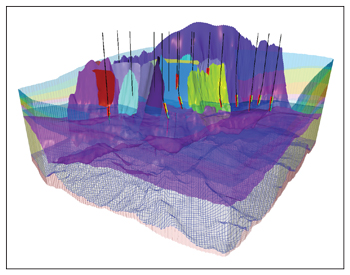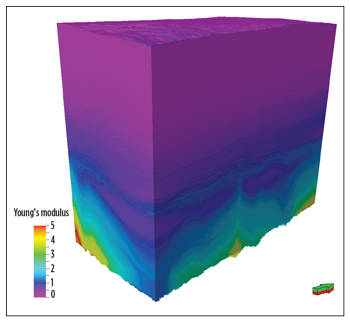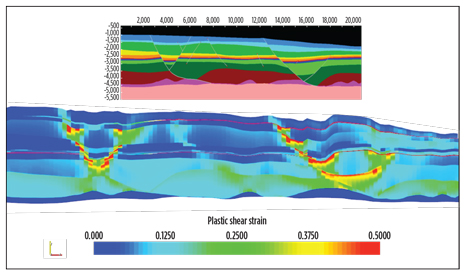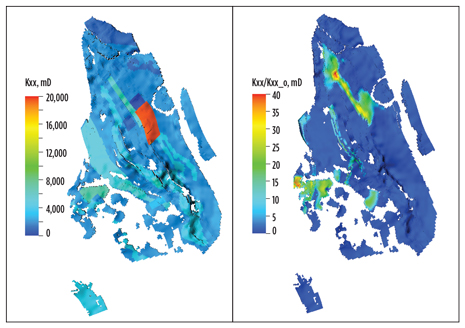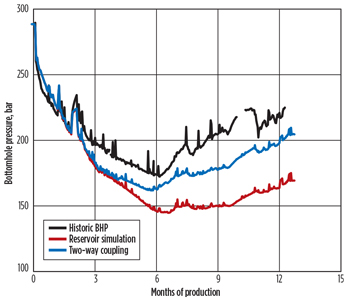Integrated 3D geomechanics and reservoir simulation optimize performance, avoid fault reactivation
Fault reactivation is a significant deepwater hazard offshore Brazil.
|
The main reservoirs in Brazil’s deepwater basins consist of soft, high-porosity sandstones, many of which are highly faulted and fractured. Under lithostatic pressure from overlying rocks, most of these faults have achieved relative tectonic stability for millions of years. However, even a slight alteration of the stress field within a hydrocarbon reservoir, or its overburden, can trigger dormant faults to slip. Rapid pressure depletion through production and pressure changes, due to water injection, may be sufficient to disturb the in-situ stress regime and reactivate faults. Fault reactivation has a range of potential consequences, including the shearing of casing, which can cut off production; the creation of additional fault compartments, which may isolate reserves; and the opening of unintended leakage pathways between adjacent formations or, worse yet, between the reservoir and ocean floor. These can lead to significant environmental impact and economic loss. Several such incidents have occurred in recent years, both in Brazil and elsewhere. As a result, it has become increasingly critical for operators in complex geological settings to understand how to manage injection pressures and maximize reservoir performance, while mitigating the risks of fault reactivation, compaction, subsidence, sand production and other geomechanical complications. Recent advances in the emerging discipline of reservoir geomechanics, including the two-way coupling of 3D geomechanical modeling with traditional reservoir simulation, provide new and technically superior ways of achieving these strategic objectives. FIELD STUDYPortions of a highly faulted Oligocene turbidite reservoir in a deepwater field offshore Brazil had been subjected to water injection at several points in time. The large number of faults and fractures, as well as the high porosity and compressibility of the reservoir, made this field more complex to manage than certain others in the basin. When oil production began in 2008, early geomechanical analysis set the maximum injection pressure at 70 bar above the initial reservoir pressure. However, when Petrobras discovered that a small reservoir nearby had undergone fault reactivation, due to aggressive water injection several years before, a special geomechanical work group was formed to study the problem in greater detail. To avoid potential fault reactivation and reservoir deformation, the group decided to reduce the maximum injection pressure to approximately 5 bar above initial reservoir pressure. Of course, this lower injection rate had an impact on incremental oil production and recovery. Therefore, Petrobras set a high priority on better understanding the geomechanics and determining the highest injection pressure that could be applied safely in the field. To that end, Petrobras entered into a technology collaboration agreement with the Schlumberger Brazil Research Center in Rio de Janeiro in 2009, with assistance from the Schlumberger Geomechanics Center of Excellence in the UK. The goal was to co-develop a systematic methodology for geomechanical reservoir characterization that could ensure injection and production optimization in the field, as well as other complex, challenging reservoirs in offshore Brazil, both soft sandstones and carbonates—and, ultimately, pre-salt reservoirs. By better predicting changes in reservoir stress and strain induced by production and water injection, the joint company team aimed to improve the assessment of wellbore stability, overburden integrity, rock fracturing and fault reactivation potential. The team drew upon specialists in multiple domains, including geophysics, geology, petrophysics, rock mechanics and reservoir engineering, to develop a new integrated workflow that coupled advanced 3D geomechanical modeling with conventional reservoir simulation. The project, which kicked off in January 2010, began with a comprehensive geomechanics data audit. This involved the collection and analysis of existing 3D seismic data, offset well logs and cores, and historical drilling information, using the Petrel E&P software platform. Mechanical earth model construction and calibration. Based on data from wells across the field under study, the team proceeded to construct an initial mechanical earth model (MEM), a quantitative representation of the stress state and rock mechanical properties of the interval of interest, Fig. 1.
Guided by well log information and a complete lithostratigraphic model, faults and geological horizons were interpreted from seismic data and incorporated into the model to ensure consistency. Sonic logs and petrophysical analysis were used to estimate initial elastic and rock strength properties. Laboratory rock mechanics testing was performed on cores from both the reservoir and overburden to calibrate log-derived dynamic properties, and facilitate correlations between those properties and their static or mechanical equivalents. For example, rock properties were defined by applying correlations, based on sonic slowness, density, porosity and clay volume. Then vertical and horizontal stresses, and stress directions, were estimated, especially around faults, using various techniques. Since traditional layer-cake modeling, based on well log data alone, had failed previously to capture strong lateral variations in rock elastic and strength properties, simultaneous seismic inversion was used, instead. Constrained by sonic logs, seismic inversion was applied to both the reservoir and overburden to distribute critical properties, such as Young’s modulus, a measure of resistance to elastic deformation under stress, Fig. 2.
To calibrate the resulting three-dimensional MEM and verify the reliability of its predictions, the team reproduced a number of actual drilling and wellbore stability events in offset wells. Rock properties, stress field, and deformation strains were modified accordingly. Structural restoration and 2D forward geomechanical modeling. Structural restoration methods, originally developed to validate geological interpretations and maps, can also assist geomechanical specialists in characterizing the geometry and distribution of strains, stresses, and other mechanical properties of deformed areas. The method was applied to a regional framework model covering a 600-sq-km area, 4,500–5,000 m deep, including 12 horizons and 78 faults. The region is characterized by a large-scale, dominantly extensional fault-rollover structure, with listric normal faults extending down to a flat décollement surface within the underlying salt layer. Total finite extension (elongation or stretch) varies from 15% to 26% in different areas. By sequentially reconstructing the evolution of fault-and-fold systems over the past 125 million years, the team achieved a better understanding of the main deformation events; estimated finite strains, paleo-stresses, and plasticity; further refined the numerical MEM; and used the results to guide subsequent modeling. Next, 2D geomechanical forward modeling was performed, using the VISAGE finite-element geomechanics simulator to investigate the mechanical behavior of MEM layers through geological time. To determine the amount of rock compaction caused by overlying formations, for example, a series of sensitivity analyses helped define the pre-consolidation pressure of each layer. Comparisons between the present-day thickness of layers from seismic interpretation and geomechanical forward modeling showed excellent agreement. As a result, the team was able to have a first estimate of pre-production pore pressure and fault elastic properties, based upon effective stress and shear strains on fault and fracture zones for use in the 3D geomechanical model, Fig. 3.
Coupled 3D geomechanical modeling and reservoir simulation. Case histories of geomechanics activity associated with production date back many years. The earliest reported example is ground subsidence at Goose Creek oil field in Texas, in 1926. More recently, high-porosity North Sea chalk fields that underwent very rapid pressure drawdown, due to production, have been geomechanically modeled extensively. Huge changes in vertical and horizontal stresses led to compaction of the reservoir, fault reactivation, casing deformation and shearing in the overburden, and subsidence of the seafloor. Conventional reservoir simulators, designed to model changes in permeability, porosity, reservoir pore pressure and temperature under flow conditions, have no way of accurately modeling geomechanical stress and strain. While a typical reservoir simulator can apply a simple vertical stress to the model, it cannot handle the full stress tensor, which includes horizontal components, as well. As such, it cannot predict the failure behavior of faults reliably, and cannot identify potential leakage pathways or compartments as pressures change over time. To achieve a full characterization of stress and strain throughout a complex geological structure, 3D geomechanical modeling is performed separately. However, to obtain meaningful production forecasts and properly value fields, the geomechanical simulator must be coupled with a traditional reservoir simulator. The most effective approach is two-way coupling, which establishes a full iterative loop between simulators. With this approach, the team first modeled complex pressure changes across the field, caused by water injection, natural variations in porosity and permeability, and depletion due to production using the ECLIPSE industry-reference reservoir simulator. Feeding these pressure changes into the geomechanical simulator drove predicted changes in stress and strain. These changes, in turn, were fed back into the reservoir simulator to update the porosity and permeability of each part of the reservoir through time. To fully investigate geomechanical responses during production and injection, the 2.5-million-cell reservoir model was extended an additional 3.9 million cells. Thirty-five layers of overburden were added above the reservoir, extending upward to the seabed, and 36 layers of underburden. About a dozen grid cells of sideburden were added. Faults were modeled as sealing and nonconductive elements prior to production, with material properties weaker in strength and lower in elastic stiffness than the surrounding rocks. Close agreement between stresses from the 3D MEM and 1D MEMs, along individual well trajectories, indicated that the in-situ 3D stress state was being properly simulated. Observations and outcomes. Expert evaluation of the 3D geomechanical model showed that the presence of faults had a significant impact on stress magnitudes and direction, as expected. Two-way coupled geomechanics and reservoir simulation allowed for analysis of the evolution of higher plastic shear strains in locations along various faults, occurring, in some cases, even before production had begun. The risk of creating leakage pathways was far greater along these faults. The 3D geomechanical modeling enabled the team to identify areas of higher and lower risk of fault reactivation, allowing them to guide the placement of future injectors. Two-way, coupled geomechanical modeling and reservoir simulation also explained a number of reservoir behaviors much better than traditional methods. Prior to coupling, for example, reservoir engineers had been unable to accurately represent production history without adding an artificial high-permeability channel to the reservoir model. However, the coupled model clearly showed that shear plastic strains along a certain fault had increased horizontal permeability in that area, Fig. 4. Indeed, significant deformation had occurred around a number of wells and faults, especially in the later stages of production. Successful modeling of stress changes, due to depletion, allowed engineers to better predict potential areas of wellbore collapse and mud losses during drilling, sand production and compaction-induced casing failure. Adjusting mud weights and adding extra casing enabled them to drill safely through depleted reservoirs.
Two-way coupling also enhanced the project team’s ability to predict bottomhole pressures as a function of time. Compared with traditional reservoir simulation, the coupled method substantially improved the match between actual and simulated pressure measurements, Fig. 5. This was critical, of course, because, without the ability to represent pressure behavior, it would have been difficult to forecast production. By the conclusion of the joint company project, in late 2012, the team was able to gain better understanding of the complex conditions affecting the behavior of this faulted turbidite reservoir, and determine limits for injection and reservoir pressures for production without reactivating faults.
IMPLICATIONS AND APPLICATIONSAs part of the joint technology agreement, Petrobras and Schlumberger patented a new technique for rapid assessment and screening of potential geomechanical risks. Building the 3D geomechanical model of the field also led to a series of correlations that enable asset teams to estimate mechanical properties elsewhere in the area. Finally, Petrobras has developed a comprehensive workflow for reservoir geomechanics characterization that represents a new standard for future studies in soft sandstones, certain carbonates, and various pre-salt reservoirs. Integrated 3D geomechanical modeling and reservoir simulation offers significant benefits, not only to deepwater fields offshore Brazil, but also in many other fields worldwide, wherever geomechanical deformation is having a serious impact on production. Several years ago, for example, the operator of a major high-pressure, high-temperature field in the North Sea was forced to shut in development for a period of time, due to the difficulty of accurately modeling pressure depletion effects. Some chalk fields in the North Sea, notably Ekofisk, have experienced more than 30 ft of compaction and subsidence. Even strong carbonate reservoirs in the Middle East and North Africa are suffering geomechanical effects. In one old field with fractured Cambrian reservoirs, changing stresses and strains have been disturbing the permeability of the fractures. Geomechanical modeling is helping operators identify where to place additional injectors and producers to improve reservoir drainage. Advanced 3D geomechanical modeling and simulation, especially coupled with conventional reservoir simulation, is still a relatively new technique in the upstream industry. Nevertheless, this type of workflow is likely to become more common in the coming years, as operators expand from solving the geomechanical challenges of structurally complex conventional environments to unconventional plays, |
- Coiled tubing drilling’s role in the energy transition (March 2024)
- Using data to create new completion efficiencies (February 2024)
- Digital tool kit enhances real-time decision-making to improve drilling efficiency and performance (February 2024)
- E&P outside the U.S. maintains a disciplined pace (February 2024)
- U.S. operators reduce activity as crude prices plunge (February 2024)
- Drilling advances (January 2024)
- Applying ultra-deep LWD resistivity technology successfully in a SAGD operation (May 2019)
- Adoption of wireless intelligent completions advances (May 2019)
- Majors double down as takeaway crunch eases (April 2019)
- What’s new in well logging and formation evaluation (April 2019)
- Qualification of a 20,000-psi subsea BOP: A collaborative approach (February 2019)
- ConocoPhillips’ Greg Leveille sees rapid trajectory of technical advancement continuing (February 2019)

